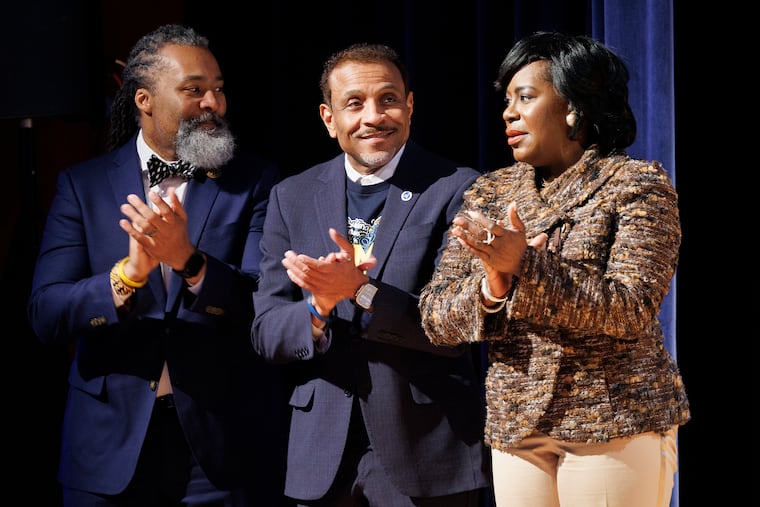Parker says she can’t give more money to Philly schools this year, and other takeaways from the City Council school budget hearing
Parker also announced that more schools will get her "year-round" model that gives before- and after-school programming and summer childcare options.

The Philadelphia School District plans to spend $300 million of its reserves to avoid losing staff and cutting programs next school year.
Absent increased state or local funding, it faces a deficit for the 2025-26 school year that will swell to $2 billion over five years. The school board is expected to pass a $4.6 billion budget at the end of May.
But despite calls from some City Council members to increase the district’s share of city property tax collections in the next budget cycle, Mayor Cherelle L. Parker said Tuesday that she cannot support that shift.
The city increased the district’s share of property taxes to 56% this year, netting an additional $12 million for city schools; Parker has said she wants to reach 56.5%, but not until 2030.
“Some members of Council affirm that we should be doing more, we should be doing more, sooner, and you know I agree — I love the idea of doing more, but this is what we can achieve given all of the other demands on our city,” Parker told Council on Tuesday, speaking at a hearing on the school system’s budget.
Parker campaigned on a promise to increase the share of city taxes allocated to the district from 55% to 58%.
“I’m on the record as making of that commitment, and I’ve never been one to try to shy away from any commitments that I’ve made, but we have to do it in a fiscally responsible manner,” the mayor said.
Here are three takeaways from the Tuesday hearing:
Digging deep into reserves is the right move, leaders said
Both Superintendent Tony B. Watlington Sr. and school board president Reginald Streater stood by the district’s move to dig deep into its rainy-day fund to keep spending levels where they are this year. That will not be possible moving forward.
The district has posted progress in most academic measures — reading and math proficiency and graduation rate increases, dropout rate decreases.
“We feel confident we are on the right path and remain committed, Council President, to pushing forward with urgency and care, even as we face uncertainty, including around federal funding. Our commitment is unwavering: We will not be pressured into decisions that compromise student safety or well-being,” Streater said.
More schools will get year-round programming in September
Year-round school was another key campaign promise of Parker’s, though it has now been rebranded as “extended-day, extended-year” programming.
This year, 20 district schools and five city charters have before- and after-school programming, in addition to childcare during school breaks and in the summer — all free to families. (Parker initially discussed having year-round school, but to date, the extra programming is staffed by outside providers, not certified teachers. The Philadelphia Federation of Teachers contract, which expires in August, does not allow for year-round school, and it is not clear whether a renegotiated contract will allow for that programming.)
“Our hope is that we plan to expand the extended-day, extended-year program to include 10 more district schools in September, as well as five more charter schools, increasing the number of extended-day, extended-year schools from 25 schools to 40 schools,” Parker said.
The list of new schools getting the extra programming has not been made public. The city has budgeted $24 million for the programs in the 2024-25 school year.
Right now, 38% of the extended-day, extended-year program before-school care seats are full, and 81% of after-school seats.
The impact of the programming is not yet clear, but Watlington told Council that 80% of students enrolled in the programming have 90% attendance or better, compared with the district’s overall rate, which stands at 65%.
Some Philly schools have low proficiency as measured by state tests
A number of schools in Councilmember Jeffery “Jay” Young’s North Philadelphia-based district — and a number of schools in the 216-school district as a whole — have zero or very few students meeting state standards in some academic areas.
“In third grade, they don’t know math,” Young said.
Young asked how the district was going to get students to where they ought to be.
Streater said the school board’s “goals and guardrails” accountability framework was keeping close tabs on academics in an effort to align resources with needs and to drive achievement.
Both he and Watlington underscored the district’s progress — slow, but steady, with fewer children in the lowest tier of achievement, “below basic.”
Watlington, a runner, likened it to athletes trying to shave 10 minutes off their personal record time. If they improved by nine minutes, they still would have missed the target, but the progress counts for something, he said.
“There are children who don’t hit the cut score, but you can see they’re getting closer,” Watlington said.
Still, not making proficiency limits kids’ abilities for postsecondary opportunities, the superintendent noted.
“What keeps us up at night is those children who are at zero to very low proficiency,” Watlington said.
Council is scheduled to hear public testimony on the district’s budget on Wednesday.